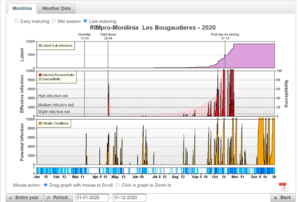Brown Rot (monilnia spp.) model
Brown rot caused by Monilinia fructicola, M. laxa, and M. fructigena is the most important disease in stone fruit production. Flowers, twigs, and fruits can show symptoms of the disease during the growing season. However, it is the latent, asymptomatic fruit infections that are the most damaging as they cause post-harvest fruit rot in the supply chain.
The video with detailed explanations about this model is available here
The Model
In the bar below the graph, dark blue represents the periods when your weather station recorded rain. Light blue is the period when the leaves are wet, based on your records of rain, relative humidity and leaf wetness.
The lower graph simulates infections based solely on weather conditions.
The middle graph simulates the real risk of infection depending on the phenological stage (flowering, fruit ripening). The phenology and the sensitivity of the multiple varieties of cherries, plums, nectarines, apricots, etc., can be very different. The user must enter the flowering and harvest date to allow the model to produce useful information.
The user can enter the green tip/start of flowering/harvest for three types of early, mid-season and late varieties. He can then switch from one simulation to another directly by clicking on the type of variety above the graph.
In the example below, the late stone fruit varieties in this orchard are affected by severe infection during flowering, resulting in flower infections. Potential consecutive infection events (in June and July) do not result in infected fruits because the fruits are not yet susceptible. In August-September, when the fruits ripen and susceptibility increases, a series of serious infections occur just before and during harvest. The result is an increase in latent infections that will manifest in the fresh fruit supply chain.
